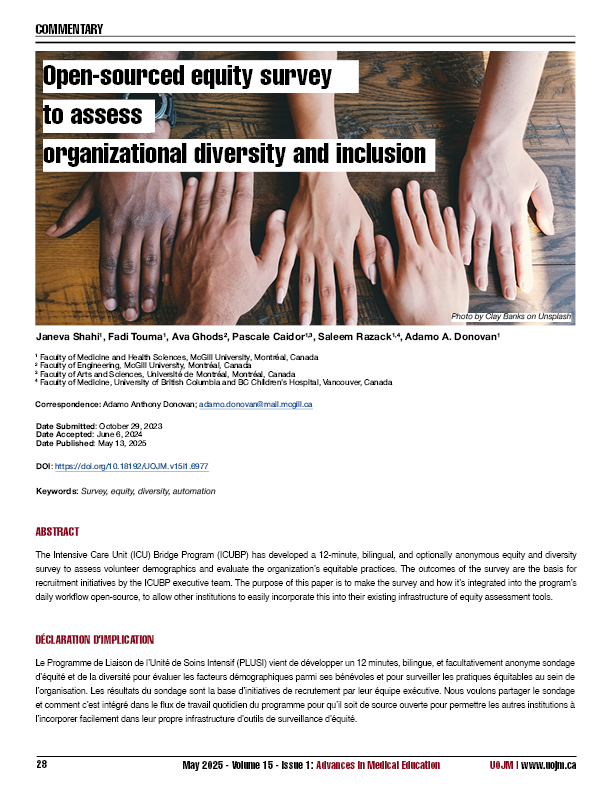Open-sourced equity survey to assess organizational diversity and inclusion
DOI:
https://doi.org/10.18192/uojm.v15i1.6977Keywords:
survey, Equity, diversity, automationAbstract
The Intensive Care Unit (ICU) Bridge Program (ICUBP) has developed a 12 minute, bilingual, and optionally anonymous equity and diversity survey to assess the demographics among volunteers and to evaluate equitable practice within the organization. The outcomes of the survey are currently the basis for recruitment initiatives by their executive team. The purpose of this paper is to make the survey open-source to allow for other institutions to use it as a resource and source of information to set the foundation and/or build on their own equity assessment tools and incorporate these into their existing infrastructure.
----------
Le Programme de Liaison de l’Unité de Soins Intensif (PLUSI) vient de développer un 12 minutes, bilingue, et facultativement anonyme sondage d’équité et de la diversité pour évaluer les facteurs démographiques parmi ses bénévoles et pour surveiller les pratiques équitables au sein de l’organisation. Les résultats du sondage sont la base d’initiatives de recrutement par leur équipe exécutive. Nous voulons partager le sondage et comment c’est intégré dans le flux de travail quotidien du programme pour qu’il soit de source ouverte pour permettre les autres institutions à l’incorporer facilement dans leur propre infrastructure d’outils de surveillance d’équité.
References
Shen MJ, Peterson EB, Costas-Muñiz R et al. The Effects of Race and Racial Concordance on Patient-Physician Communication: A Systematic Review of the Literature. J Racial Ethn Health Disparities. 2018;5(1):117-40. https://doi.org/10.1007/s40615-017-0350-4
Bouye KE, McCleary KJ, Williams KB. Increasing Diversity in the Health Professions: Reflections on Student Pipeline Programs. J Healthc Sci Humanit. 2016;6(1):67-79. PMID: 29644118; PMCID: PMC5890504.
Petrecca S, Goin A, Hornstein D et al. The ICU Bridge Program: volunteers bridging medicine and people together. Crit Care. 2022;26:346. https://doi.org/10.1186/s13054-022-04209-4
Underrepresentation in health professions programs and Monitoring Progress [Internet]. Social Accountability and Community Engagement Office; 2021 [cited 2023Feb26]. Available from: https://www.mcgill.ca/med-saceoffice/about/widening-participation-committee/underrepresentation-health-professions-programs-and-monitoring-progress
Equity, diversity and inclusion learning path for executives [Internet] Service CSPS Government of Canada; 2023 [cited 2023Feb26]. Available from: https://www.csps-efpc.gc.ca/diversity-inclusion-eng.aspx
Ventrella CR, Taifour T, Rendon L et al. Five ways to get a grip on organizational logistics, backends, and workflows. Can Med Educ J. 2022;13(6):80-9. https://doi.org/10.36834/cmej.73818

Downloads
Published
Issue
Section
License
Copyright (c) 2025 Janeva Shahi, Fadi Touma, Ava Ghods, Pascale Caidor, Saleem Razack, Adamo Donovan

This work is licensed under a Creative Commons Attribution-NonCommercial-NoDerivatives 4.0 International License.
- Authors publishing in the UOJM retain copyright of their articles, including all the drafts and the final published version in the journal.
- While UOJM does not retain any rights to the articles submitted, by agreeing to publish in UOJM, authors are granting the journal right of first publication and distribution rights of their articles.
- Authors are free to submit their works to other publications, including journals, institutional repositories or books, with an acknowledgment of its initial publication in UOJM.
- Copies of UOJM are distributed both in print and online, and all materials will be publicly available online. The journal holds no legal responsibility as to how these materials will be used by the public.
- Please ensure that all authors, co-authors and investigators have read and agree to these terms.
- Works are licensed under a Creative Commons Attribution-NonCommercial-NoDerivatives 4.0 International License.

